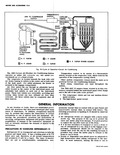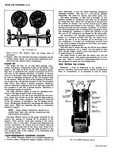Jeep Parts Wiki | Ford Parts Wiki
Home | Search | Browse
|
Corvair Chassis Shop Manual December 1964 |
|
Prev

 Next
Next
required to raise the pressure in the container higher than the pressure in the system during the operation It would be unwise to place the drum on a gas stove radiator or use a blow torch while preparing for the charging operation for a serious accident can result Don t depend on the safety plug many drums have burst when the safety plug failed Remember pressure can be a powerful force A bucket of warm water not over 125 F or warm wet rags around the container is all the heat that is required Do not weld or steam clean on or near the system Welding or steam cleaning can result in a dangerous pressure buildup in the system When filling a small drum from a large one never fill the drum completely Space should always be allowed above the liquid for expansion If the drum were completely full and the temperature was increased hydraulic pressure with its tremendous force would result Discharging large quantities of Refrigerant 12 into a room can usually be done safely as the vapor would produce no ill effects however in the event of an accidental rapid discharge of the system it is recommended that inhalation of large quantities of R 12 be avoided This caution is very important if the area contains a flame producing device such as a gas heater While R 12 normally is nonpoisonous heavy concentrations of it in contact with a live flame will produce a toxic gas The same gas will also attack all bright metal surfaces Protection of the eyes is of vital importance When working around a refrigerating system an accident may cause liquid refrigerant to hit the face If the eyes are protected with goggles or glasses no serious damage can result Just remember any R 12 liquid that you can touch or that touches you is at least 21 7 F below zero The eyeballs can t take much of this temperature If R 12 liquid should strike the eyeballs here is what to do 1 Keep calm 2 Do not rub the eyesl Splash the affected area with quantities of cold water to gradually get the temperature above the freezing point The use of min eral cod liver or an antiseptic oil is important in providing a protective film to reduce the possibility of infection 3 As soon as possible call or consult an eye specialist for immediate and future treatment REMEMBER An ounce of prevention is worth a pound of cure PRECAUTIONS IN HANDLING REFRIGERANT LINES All metal tubing lines should be free of kinks because of the restriction that kinks will offer to the flow of refrigerant The refrigeration capacity of the entire system can be greatly reduced by a single kink The flexible hose lines should never be bent to a radius of less than 10 times the diameter of the hose The flexible hose lines should never be allowed to come within a distance of 2 1 2 of the exhaust manifold Flexible hose lines should be inspected at least once a year for leaks or brittleness If found brittle or leaking they should be replaced with new lines Use only sealed lines from parts stock When disconnecting any fitting in the refrigeration system the system must first be discharged of all refrigerant However proceed very cautiously regardless of gauge readings Open very slowly keeping face and hands away so that no injury can occur if there happens to be liquid refrigerant in the line If pressure is noticed when fitting is loosened allow it to bleed off very slowly CAUTION Always wear safety goggles when opening refrigerant lines In the event any line is opened to atmosphere it should be immediately capped to prevent entrance of moisture and dirt The use of the proper wrenches when making connections on 1O ring fittings is important The use of improper wrenches may damage the connection The opposing fitting should always be backed up with a wrench to prevent distortion of connecting lines or components When connecting the flexible hose connections it is important that the swaged fitting and the flare nut as well as the coupling to which it is attached be held at the same time using three different wrenches to prevent turning the fitting and damaging the ground seat 1O rings and seats must be in perfect condition The slightest burr or piece of dirt may cause a leak Sealing beads on O ring connections must be free from nicks and scratches to assure a perfect seal MAINTAINING CHEMICAL STABILITY IN THE REFRIGERATION SYSTEM The metal internal parts of the Chevrolet refrigeration system and the refrigerant and oil contained in the system are designed to remain in a state of chemical stability as long as pure R 12 plus refrigeration oil is used in the system However when abnormal amounts of foreign materials such as dirt air or moisture are allowed to enter the system the chemical stability may be upset When accelerated by heat these contaminates may form acids and sludge and eventually cause the breakdown of components within the system In addition contaminates may affect the temperature pressure relationship of R 12 resulting in improper operating temperature and pressures and decreased efficiency of the system The following general practices should be observed to insure chemical stability in the system Whenever it becomes necessary to disconnect a refrigerant or gauge line it should be immediately capped Capping the tubing will also prevent dirt and foreign matter from entering Tools should be kept clean and dry This also includes the gauge set and replacement parts When adding oil the container should be exceptionally clean and dry due to the fact that the refrigeration oil in the container is as moisture free as it is possible to make it Therefore it will quickly absorb any moisture with which it comes in contact For this same reason the oil container should not be opened until ready for use and then it should be capped immediately after use When it is necessary to open a system have everything you will need ready and handy so that as little time as possible will be required to perform the operation CORVAIR SHOP MANUAL

 Next
Next